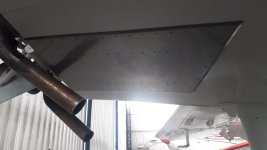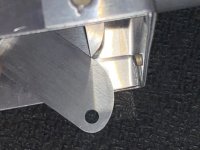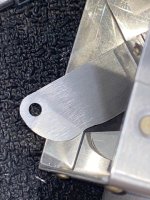Let me repeat
When a new RV builder writes he has doubts about the safety of his RV-10 as he works on his tail kit and is contemplating whether finishing it, it concerns me. My goal and mission is to support aviation, safety and building experimental planes, RV's in particular. I think we all have that common ground to work from. Its not about down playing or sensationalizing, it is about helping each other build and be safe. For all newbies these are experimental planes and on occasion you need to engineer a solution to an issue. This is the fun of building, learning and solving issues with your own ideas. I feel all RV's are very very safe planes. Keep in mind EVERY RV is unique, one of a kind, especially then systems. There are similarities, but they're amateur built and workmanship varies. Small variations result in possible large change in results. That is why following the planes is important, but in the end they're called experimental for a reason. The 40 hours Phase I is for working out issues like HOT TUNNELS, and IMHO it can be worked out satisfactory without major modification or effort. Don't accept less than 100% for safety sake.
caitlinRV said:

gmcjetpilot My girlfriend burned her leg on the tunnel of a RV10. To her it was more than an annoyance, it was painful. I went back and read the threads about this issue. Please don"t downplay it. You talked to Vans Aircraft, and then said this really is not much of an issue, but the company did issue a Service Bulletin on the subject so they must be aware there is a problem.
I am so sorry for your Girlfriends injury, but let me repeat, not everyone has the same level of problem. I never said it was not a problem nor that it was not hot enough to burn in some cases or trivialize you lady's injury. OK. Reading Mr Glens account, I agree 100%, not touching or wearing long pants is not acceptable or a solution.
My opinon from research is it's not a universal or unilaterally a problem for all builders. This is not wild conjector on my part. You asked nicely if I would not down play or basically shut up. I will respectfully say I'll continue to express my opinion, which obvioulsy is not as severe as others and feel is well thought out and researched.
I have talked to Van's senior staff and RV-10 builders who are not on this forum. Repeat some have a problem to a greater degree than others. I do care and that is why I have looked into it. I am not down playing anything, I am just saying: 1) Not all RV-10's have the issue to extream skin damage; 2) There is more than one solution. Bottom line the RV-10 is safe. New builders and want-a-be builders should NOT be afraid to build a RV-10. Have a good one and be careful.
szicree said:
If even one guy with a built-to-plans 10 has a first-hand report of interior surfaces hot enough to burn human skin I'd say it's a real problem. Saying that it's not an issue based on second-hand, third-hand, etc. reports or comparisons to dramatically different airframes is counter-productive.
There is a ton of great info available on this site, and I love to consider people's hypothetical explanations for unexplained problems, but for me first-hand reports trump all speculation.
No one ever said it was not a problem, did they? Again if you are writing to me than say so. I'll assume you are. I don't think I need to burn my leg personally to know it happens and also several builders don't have a problem as severe as others. Your milage may vary. There are a lot of folks that don't participate on this list I talk to that are RV-10 builders or work for Van's. Just passing info on.
However let's make it clear, I don't approve of burned girlfriends and vapor lock.
rv6ejguy said:
The tunnel structure on the 10 is not like any other Vans design to date. It carries the cabin heat ducting and major part of the fuel system, totally enclosed. Comparisons to other RVs are hardly valid. The fact that there have been burned legs and engine stoppages due to vapor lock plus a Vans directive on the issue proves that this is a really problem. Downplaying the significance of it serves no purpose other than to compromise safety.
Let me say the big difference is the RV-10 has a 6 cylinder engine (more heat) and two large heat muffs. Most two seater RV have one heat muff off of one or two cylinders, not the full heat of 6 jugs. I think the cabin heat leakage and hot firewall from the twin heat muffs is one of the prime issues.
"It carries the cabin heat ducting and major
part of the fuel system, totally enclosed."
You are only part right and you apparently are not familiar with RV-7's which do have the fuel and cabin heat (not ducting but hot air) and major part of the fuel system enclosed together.
I don't think you understand the point of my comparison of the RV-10 to the RV-7 in particular (much different than your RV-6 fuel system). The intent was not to say the RV-10 does not have any issues or there's a direct correlation. My point is the RV-7 does have fuel lines in the belly (center-line) and fuel pump housed in a small box with cabin heat blowing right on it. The point, may be we, RV-7 and other like RV builder's, should see if our fuel is too hot as well. If not why? Why is a RV-7 belly so much cooler. Frankly a lot of the heat is coming from the cabin heat in my opinion (see my previous post).
As far as vapor lock, apparently Glen had 3 occurrences to figure it out, so I am sure he is right, he had vapor lock. He is a brave test pilot, since one vapor lock occurrence would have prompted me to not fly until trying to solve the problem, but that's just me. Again many have not had a problem. I want to know why.
Glen's problem's clearly are quite severe; We all know that, since he said it many times. I believe him, but am I wrong to ask others like Tom Green at Van's or other RV-10 pilots what they think and pass the info on? Q: Have you heard of such severe RV-10 hot tunnel symptoms?
I'll say one more time and politely, may I suggest we all calm down, stop being sensational and just solve the problem with polite discussion. If you disagree fine, but please allow room for more than one idea. More ideas the better. Not all will be jewels. There is clearly a problem but it's not a universal problem with all RV-10 builders; prove I am wrong without attacking me as uninformed. Inform me don't try to discredit. For those who have severe problems, like Glen, I empathize and wish all the best.
It would be refreshing to talk facts and ideas than make comment about who is making the suggestions or if their input is more or less worthy. Just advice, you never know where the good info will come from, so listen to everyone, even me sometimes.

We agree to disagree. Just trying to help. There's no need to be combative or emotional. It's just an engineering problem to me; it's not a personal issue with anyone.

Any one else want to pile on? So just for the record Glen has some serious and real problems. I think his input should be considered by any builder. I don't argue with success, and if Glens SS belly sheet solution works, do it if you like. I personally would try other methods first as previously outline.







